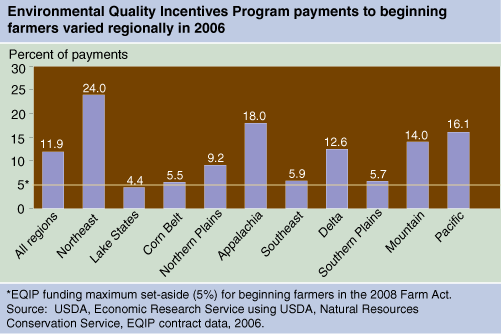Conservation Program Provision May Have Limited Impact on Underserved Farmer Participation
- by Michael S. Hand and Cynthia Nickerson
- 11/1/2008
Several provisions of the 2008 Farm Act target traditionally underserved groups—beginning, limited-resource, and socially disadvantaged farmers—in an attempt to increase their access to conservation funds, farm loans, crop insurance, and other farm programs. The effect of such provisions often depends on the degree to which they address unmet demand for program participation by the underserved groups. For example, at least one of the Act’s new provisions for underserved farmers may have limited effect nationwide since participation by beginning farmers in the Environmental Quality Incentives Program (EQIP) already exceeds the goals set in the Farm Act.
In the past, beginning and limited-resource farmers have been eligible for higher payment rates and other targeted participation incentives in EQIP. The 2008 Farm Act builds on these provisions by setting aside 5 percent of funding in EQIP and available acres in the Conservation Stewardship Program (CSP) for beginning farmers, and 5 percent for socially disadvantaged farmers. Beginning farmers are defined as those who have operated a farm or ranch for less than 10 years. Socially disadvantaged farmers are defined as members of a group that has experienced racial or ethnic prejudice. These groups typically include Hispanics and non-Whites. Limited-resource farmers are not eligible for the set-asides in EQIP and CSP if they do not meet the beginning or socially disadvantaged farmer criteria. Limited-resource farmers are farmers who in each of the past 2 years had gross farm sales below $116,000 (in inflation-adjusted 2005 dollars) and low household income.
Many beginning and socially disadvantaged farmers are competitive enough to receive program funding without a specific funding set-aside. But if these farmers claim less than the legislated 5-percent set-aside funds, additional less-competitive underserved farmers may be able to participate without having to vie with nontargeted farmers for EQIP funds and CSP acreage. At some point during the year, unused set-asides are released for use by nontargeted farmers.
Payments to beginning farmers accounted for 12 percent of all EQIP payments in 2006, suggesting the national 5-percent funding set-aside will not increase beginning farmer enrollments in future years. However, if the 5-percent funding set-aside is administered by regions, then the Lake States region (including Michigan, Minnesota, and Wisconsin) may see a slight increase in EQIP participation by beginning farmers. Payments to beginning farmers in this region were below the 5-percent threshold in 2006.


